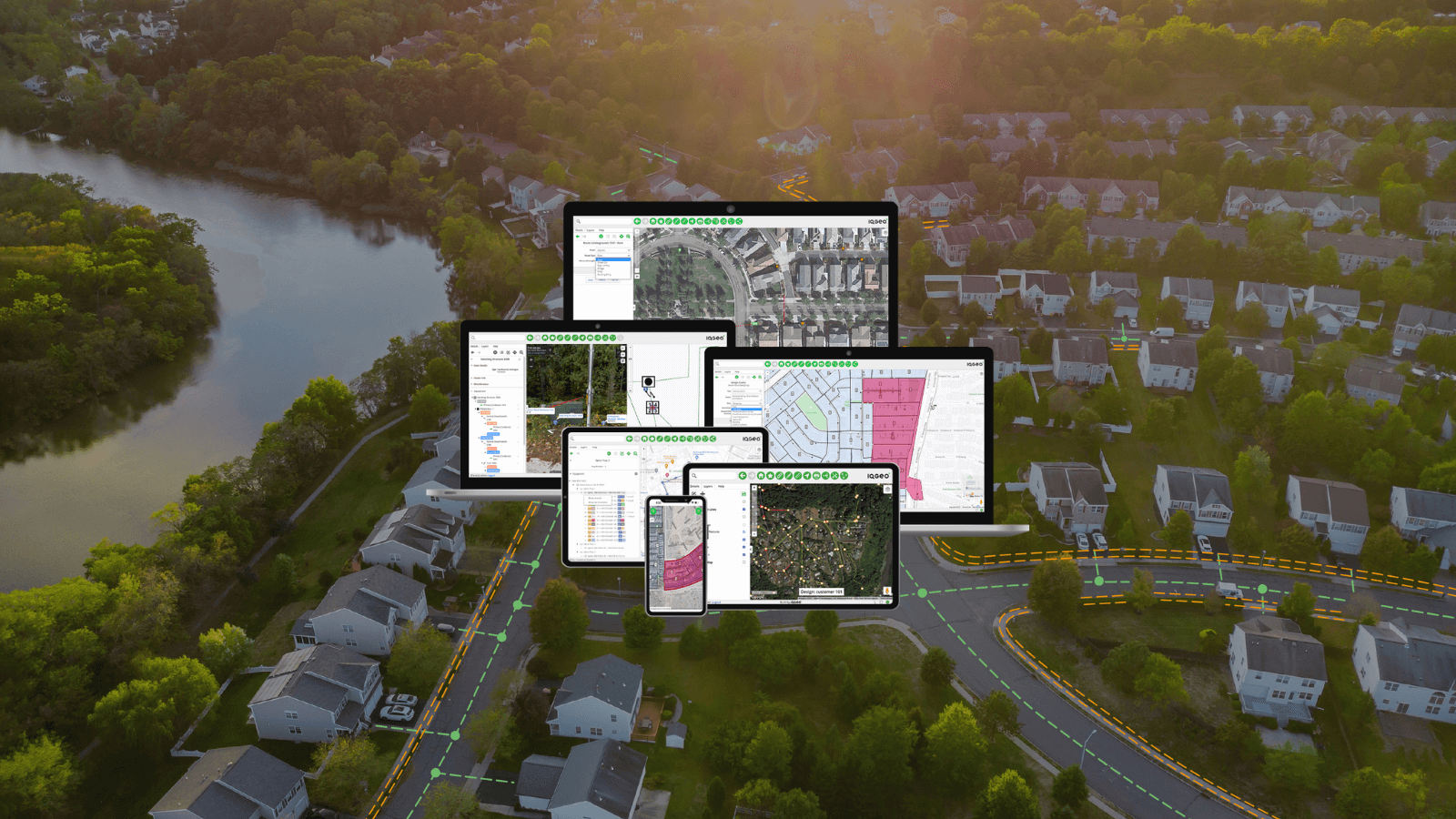As the demand for high-speed connectivity skyrockets, the challenge of efficient fiber network construction has never been more pressing. Recently, IQGeo, in collaboration with the Fiber Broadband Association, hosted a webinar to explore innovative strategies that empower operators to meet this demand by effectively bridging the gap from fiber design to network construction. During the webinar IQGeo’s James Wheatley, Head of Product Management and Troy Freissle-Lewis, Software Product Manager discussed how we can help solve operators’ construction management challenges and help them build better networks.
How IQGeo helps telecom operators build better networks
IQGeo helps operators to plan, design, operate and build better networks. We do this by slashing network design time up to 90%, cutting construction costs by as much as 10%, reducing Mean Time to Repair (MTTR) in the office and field, and enabling you to generate sales quotes in minutes, rather than days.
We combine our flexible geospatial network models with our task automation software that ultimately helps operators build and operate better networks more effectively and efficiently.

The focus of this webinar was on the construction stage, exploring how to use the right tools, and have the right people, in the right place, at the right time to accelerate the transition for design to construction.
Challenges telecom operators face
From our conversations with customers and observations within the telecom industry, it is clear that operators face three main business challenges that all relate to data:
• Disjointed access to operational data
Operators often use multiple systems with different permission sets, with limited data granularity and poor data governance, making it difficult to control data quality.
• Network data not available in the field
This means that network data has limited mobile functionality and poses challenges for crews when trying to operate in rural areas without access to the internet. This also means that operators can suffer from poor sync performance; they could be dealing with large volumes of tickets (lots of activity happens when it comes to constructing a FTTH network) so it is incredibly important to have good sync performance to cope with large volumes of work.
• Difficulty in maintaining data quality
As there is a lot of data that is being updated and managed, it is important that the data quality is high. Ultimately, what operators are building in the network should be reflected in a geospatial network model that is shared with key stakeholder across the business. In order to support those downstream processes, operators must understand where the network is and how it is connected. If you have poor data quality, those processes will be challenged.
We simplify data updates in the field, offering flexibility and breaking through rigid process handling.
To understand more, during the webinar, we also asked listeners in a poll what their biggest construction management challenges were. The results were:
• Visualizing data and tracking construction progress
• As-built network build in the field
These, as well as the challenges above, are all key areas we can support through our solutions. In particular, using Network Manager Telecom, field crews can update data in the field and visualize data through a single pane of glass.
How IQGeo solves these challenges
Network Manager Telecom alleviates key construction management challenges because it is built with ease-of-use at its core, especially when it comes to data management and access. It is a web-based, mobile enabled solution whereby field and office users have access to the same data and functionality regardless of location, offline or online. It also underpins the network lifecycle, which allows a common foundation for all processes across the lifecycle which helps to eliminate data silos.
Streamline digital workflows across the network lifecycle
Layered onto Network Manager Telecom is Workflow Manager, IQGeo’s geospatial task automation software. In combining the two, we create a fully integrated solution to improve workforce efficiency.
• Improved data Access
IQGeo integrates multiple systems into a single, intuitive interface, providing a comprehensive view of all physical network operational data. This unified approach enhances data governance and quality, making it easier to control and utilize data effectively.
• Mobile functionality
IQGeo’s solutions are designed with a mobile-first architecture, ensuring that field crews have the same access to data and functionality as office-based staff, whether they are online or offline. This capability is crucial for operations in rural or remote areas, where internet access may be limited.
• Streamlined data quality management
By providing a flexible and geospatially referenced network model, IQGeo simplifies data updates in the field. This flexibility helps operators maintain high data quality, ensuring that network changes are accurately captured and reflected in the system. As a result, downstream processes are better supported, and operational efficiency is improved.
The benefits of this integrated solution
• Geospatial work orchestration
The IQGeo solution brings work together from different sources and systems and presents them through a single shared geospatial view. This streamlines work into a single environment in the context of the network so that office and field crews only need to interact with one system. It also contributes to better data quality by ensuring that data is managed and updated more consistently.
• Accessibility in the field
This increases productivity by giving field crews visibility of the work that they need to do, both offline and online. It also expedites contractor onboarding and keeps work moving. Mobility solves the challenge of as-built network field data capture. The mobility workflow contributes to better data quality by enabling field updates to be immediately synchronized with the data model, creating an up-to-date and accurate view.
• Configurable workflows that scale
We understand that not all operators work the same. A level of configurability is always important to tweak the processes and the user interface. Through this configuration, operators can bring the process and the application closer together to find the sweet spot where they can begin dramatically optimize workforce tasks and streamline processes.
The key takeaway from the webinar is how IQGeo can orchestrate all aspects of fiber network management with a flexible shared geospatial model. As put by James Wheatley when referring to Workflow Manager, “we can link the assets on the map to the tickets that control the work that is being done, moving seamlessly from design into network build.”
Discover more insights and practical solutions by watching our webinar hosted with the Fiber Broadband Association. Don't miss out on expert advice and innovative strategies for your network construction projects.

CMO at IQGeo
Similar articles:




 Previous
Previous







